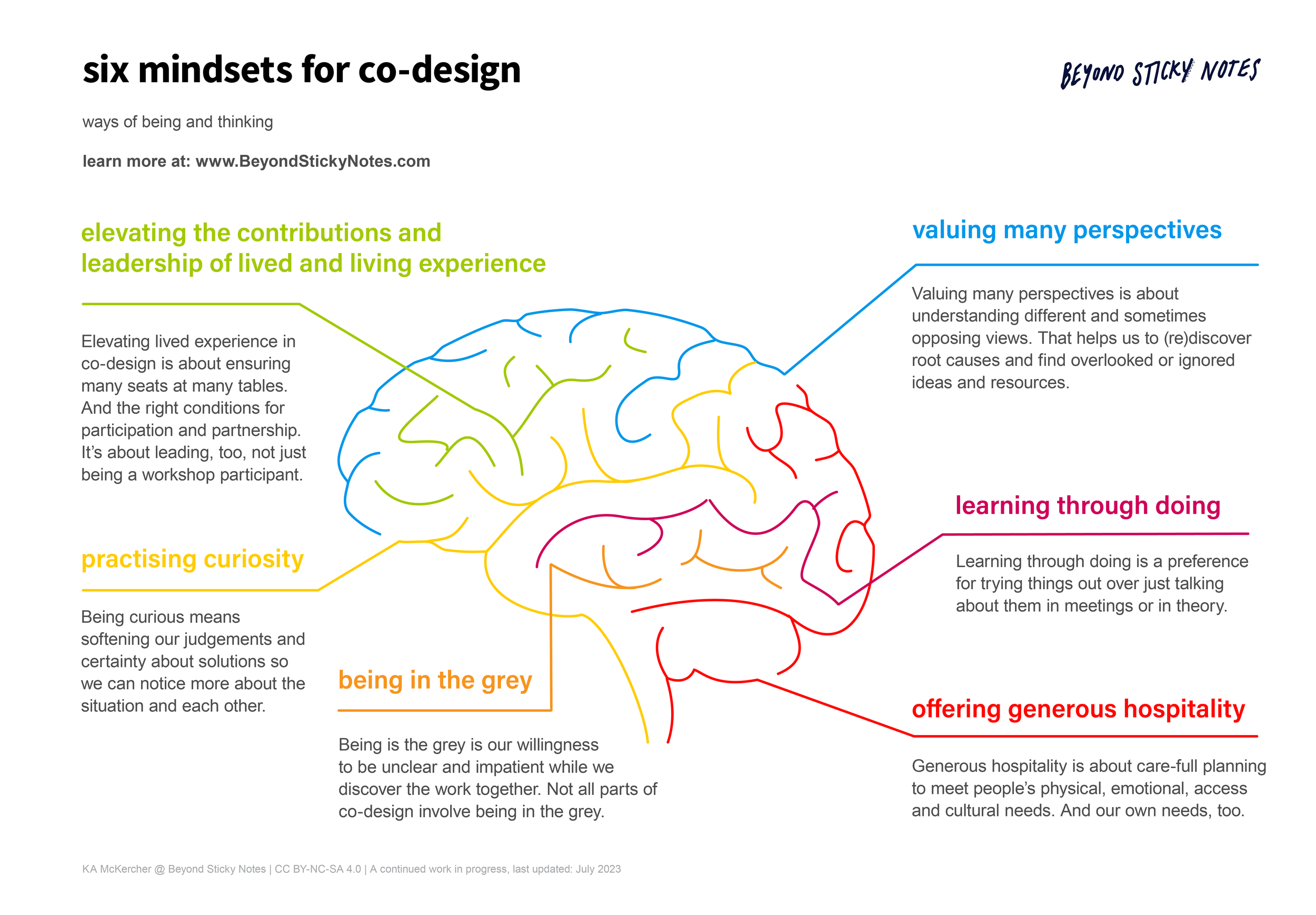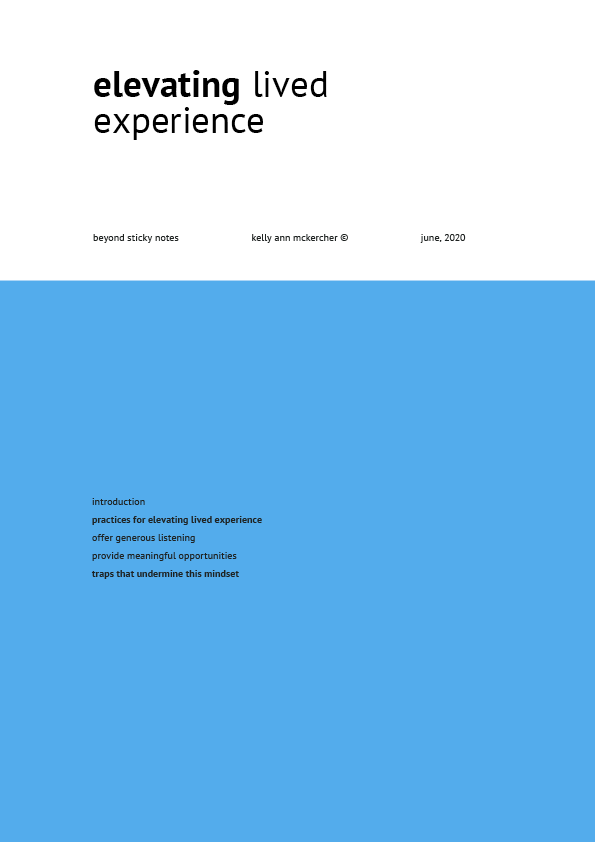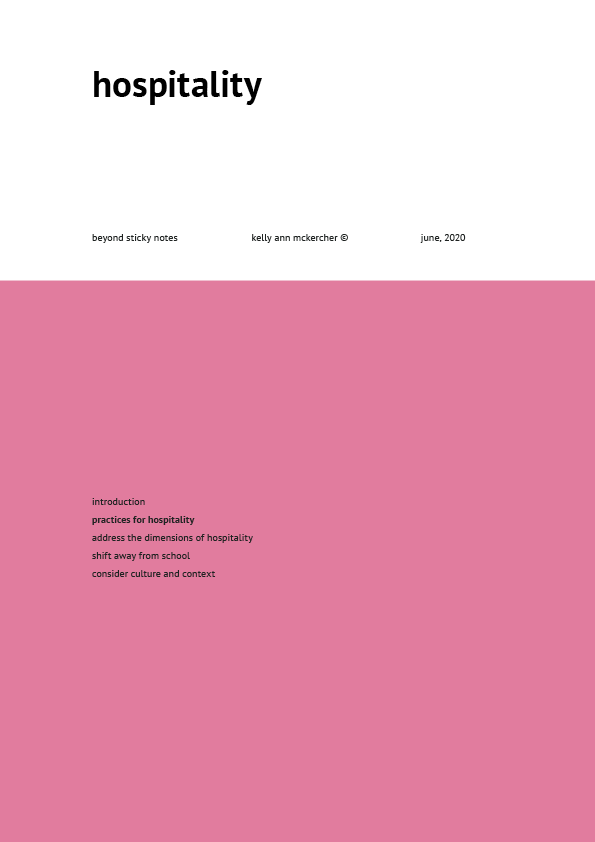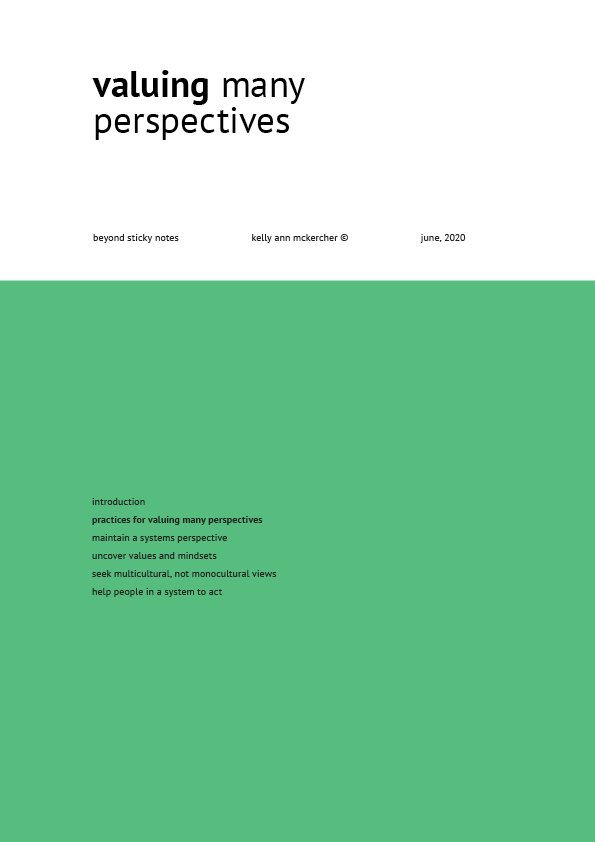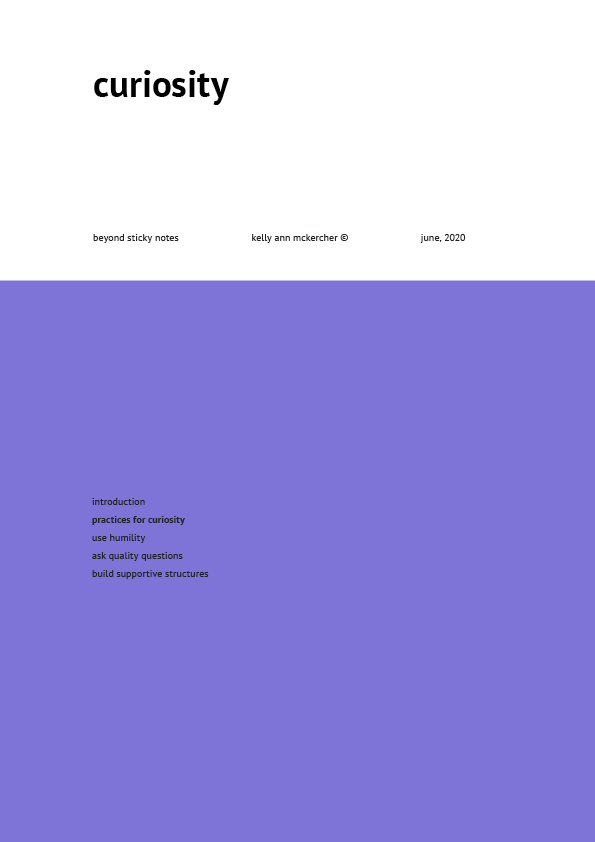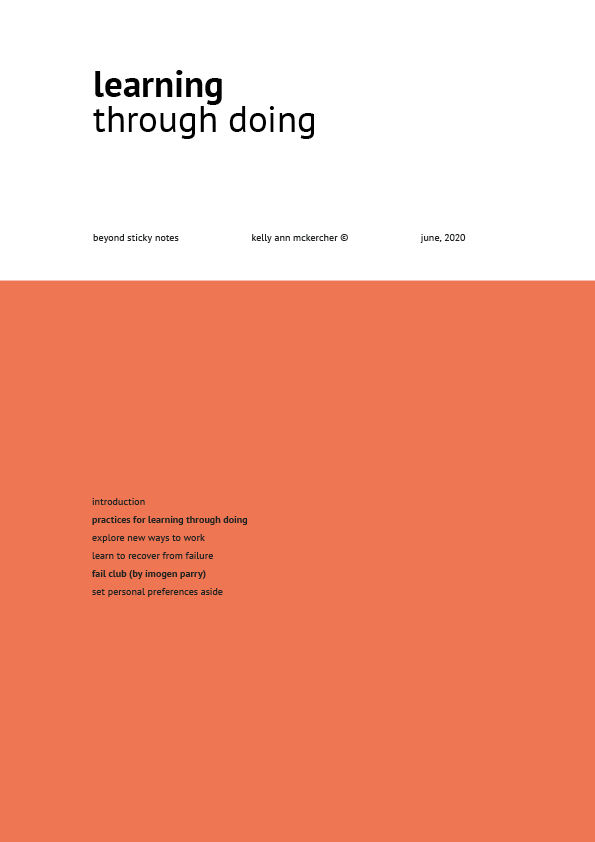six mindsets for co-design
Here are six mindsets described by KA McKercher in Beyond Sticky Notes: Doing Co-design for Real (2020).↪
Elevating lived experience
Practising curiosity
Offering generous hospitality
Being in the grey
Learning through doing
Valuing many perspectives
Poster reads: Six mindsets for co-design and features a line drawing of a brain. Coming off the brain are six mindsets: elevating the contributions and leadership of lived and living experience, valuing many perspectives, learning through doing, practising curiosity, being in the grey and offering generous hospitality.
Mindsets are ways of being and thinking that support co-design. We created them to name some things that work for and against co-design.
Co-design takes more than using creative tools, making plans or having workshops. We also need to notice how we relate to each other, how we lead, how we behave in groups and communities, what we believe and how those things support or get in the way of working together.
Despite good intentions, we often go back to ways of working that don’t support co-design (e.g. controlling others, valuing learned expertise over lived experience or rushing to solutions) when we’re stressed, un-supported, isolated or uncertain.
Reading the mindsets is a good start, but it’s not enough. We also must experience the mindsets, practise them, hold ourselves accountable, and help others do the same. Are you talking about the mindsets - or are you practising them too?
1 elevating lived experience
Too often, we speak about people and communities without them. We assume we understand other people’s needs and make important (and often costly) decisions on those assumptions. We may confuse our knowledge of providing a service with the experience of receiving a service. Or, confuse our lived experience with the experiences of others.
No one can represent all sources of lived experience
There are different sources of lived experience and expertise (see example from Safe and Equal↪)
Lived experience doesn’t belong to one sector or experience
Having a lived experience doesn’t automatically mean we can facilitate co-design
Having people with lived experience involved doesn’t automatically make something co-design
Lived experience-led doesn’t mean something is inherently just or free from harm
While stories matter, elevating lived experience is more than collecting and sharing stories
Elevating the voices and contributions of people with lived experience means challenging power differences. Including what is considered evidence, who gets heard, who gets to decide, and who is in the room.
📖 Read Evidence for Innovation by Jamie Gamble, Penny Hagen, Kate McKegg and Sue West.↪
Elevating lived experience is about shifting systems and dreaming up new possibilities for how we ‘do’ change. We have to ensure that there are many seats at many tables with the right conditions for participation and partnership.
-
How/what are folks with lived experience designing?
What opportunities are available for folks with lived experience beyond (re)telling their stories and naming problems to be solved?
Where are folks with lived experience missing from decision-making?
Where are you sharing responsibility with folks with lived experience?
Where can you build conditions to better value and elevate lived experience?
2 practising curiosity
Being curious is being open to various perspectives, ways of being and doing, and opportunities. We defer judgement to deepen our understanding of ourselves, each other and the context we’re working in. We ask questions and resist resting in our professional knowledge. Working with people doesn't mean we can speak for them. Having a lived experience doesn’t automatically mean we understand other people’s experiences.
Frustration, overwhelm, and a toxic organisational culture can damage our curiosity. Curiosity can feel like a nice to have, not something we do when we’re busy and working in scarcity.
And curiosity can be a form of resistance. Many professions reward people for asserting their views, having the answers and negotiating others into submission. The curious can be seen as troublemakers, obstructive or lacking competence. More broadly, Western culture rewards people who confidently state their opinion and who are decisive. We are taught in binaries - someone has to be right and others wrong. We must make room for curiosity.
While we don’t have to give up what we believe, we need to lay down our armour long enough to understand other perspectives. That can be hard in places where we’ve had to armour up.
Curiosity is essential to co-design, creativity and innovation. Without it, we won’t spot anything new. We’ll keep doing more of the same. Consider:
-
Where have you stopped being curious?
Where can you soften your armour to notice more about others or a situation?
How can you show others how you’re practising curiosity?
3 offering generous hospitality
Care and connection are core to co-design and the Model of Care for Co-design.↪
Hospitality can start with simple things such as knowing people’s names, ensuring warm hellos and goodbyes, or offering a cup of tea. While hospitality isn’t complicated, it’s often missing from co-design and engagement. When we offer hospitality (giving before we get) people show up and often keep showing up. When we know we’re cared about we tend to give more of ourselves.
only saying ‘this is a safe space’ doesn’t make it safe
If we can’t create a warm and welcoming environment, we pay the cost of discomfort. People are distracted and anxious; relationships and trust are slow to develop. Often, people won’t show up at all or won’t return after a negative experience. They often won’t say why they didn’t come back so we don’t learn or change how we do warmth and welcome.
The diagram below shows four dimensions of hospitality to lessen anxiety and increase connection between co-designers.
Image description: The centre reads ‘less anxiety more connection.’ There are four petals around the centre that read - you are appreciated: your effort, honesty, emotional labour and hope is valued. You are supported: We will make sure you can take part in this process. You are welcome here: Your identity, stories and emotions are all welcome here. Come as you are: There is no ‘right’ way for you to be or show up.
Overlook hospitality at your peril. While it might not matter to you, it matters. It is people’s barometer of how much you care about them and their experience. Keep hosting simple and thoughtful. Ask and offer. Use the Model of Care for Co-design↪ as your guide.
-
How might you set a tone of warmth and welcome from the first interaction with co-designers?
Where did you get your hosting or gathering habits from?
Where is hospitality missing from your convening?
What could make co-designers feel welcome?
How well do you ‘host’? If it’s not your strength, is there someone else that might better play host?
4 being in the grey
I’m yet to find someone who relishes the thought of being in the grey. It doesn’t sound great. Particularly for those who thrive in perceived order and certainty. In many contexts, we value solving problems over asking questions. We don’t want to waste time. We want to be done already.
Being in the grey is a temporary state in co-design.
However, miserable sounding, being in the grey remains one of the most vital mindsets for anyone with anything to do with co-design work, innovation and systems change. It is the ability to be in ambiguity. To sit within the discomfort of not knowing, recognise and grapple with complexity. To give ourselves over to its necessity and its gifts. Without it, our push to ‘get things done’ often leads us to hurried conclusions - incomplete, unsophisticated and rushed solutions. It can rush us to reach for the obvious and chase magic bullets. In complex change work, there are no magic bullets.
Luke Craven↪ reminds us “no single framework or theory will ever be sufficient to hold the complexity and richness of the real world."
The obvious leads us astray - it is often too simple for the complexity of our challenge. By contrast, time spent asking the right questions, ‘mulling’, deferring judgement, unpacking and exploring with others can lead to powerful insights and responses.
-
How do you relate to ambiguity?
Do you have a mix of relationships to ambiguity within your team?
What structures and incentives could encourage this mindset in your work?
How will you build time for being in the grey into your efforts? Practical things, like project plans?
5 learning through doing
Learning through doing is a preference for learning by trying things out, instead of talking about them in theory or meetings.
We learn through making things. Putting them into context with the people they will impact and judging their performance against the outcomes we want. We keep what works and discard what doesn’t, testing our assumptions early and often. We can’t test things through a theoretical conversation alone. Prototyping is the most common tool to support this mindset (read more here).
In co-design (and many other kinds of design), we hold ourselves back from rushing straight from an idea to pilot or implementation. Instead, we prototype through several loops of learning. With each loop, we test our assumptions and make changes as needed. If we do pilot a service, program, policy etc., we are very sure about what we’re doing. We’ve checked and improved - not guessed.
Here’s where it gets hard. We take all of our baggage into learning through doing. I’ve worked with many teams who agree to prototype. However, they’ve not de-conditioned themselves to be different. They get stuck in lying and hiding failure, lack the tools to recover from failure, and may work for an organisation that does not allow for, or reward learning. That needs to change, as The Centre for Public Impact↪ (and others) continue to remind us.
If we’re not learning through doing, we are in the past where we assumed what would work. Our commitment to elevating lived experience means listening to those experiences across the process - not editing feedback from communities out when it doesn’t suit us. Meetings must end when we begin guessing what people might want or need. Instead, we learn together. That’s co-design.
-
How are you building your skills for productive failure? Who can help you?
Do you default to learning through doing or to discussing and guessing?
Are you familiar with prototyping? Could you deepen your knowledge?
6 valuing many perspectives
Understanding diverse views are critical to identifying new opportunities. Diverse views help us to find the systemic causes of issues and identify overlooked resources, as well as see old issues in new ways.
It’s critical that facilitators of co-design can hold space for different perspectives to be named, explored and re-negotiated. Spaces that don't harm people but can host hard conversations. Pádraig Ó Tuama calls these “soft spaces for hard conversations.” To read more about building safe enough spaces, explore the Model of Care for Co-design and the Model of Care Digital Companion.
Co-design asks that we hold lightly to our worldview with a lot of interpersonal flexibility. We must also give up on our temptation for ‘they’ language. Language that distances us from one another. With distance diminishes curiosity and opportunity.
Co-design is about getting close up, it’s relational.
We must ensure diverse worldviews aren’t homogenised into a single set of values and ways of seeing the world. That can happen when we create reports about ‘community’ or ‘patients’, for example, that combine everyone’s experiences without explicitly calling out dimensions of difference. Read more about dimensions of difference.
The diagram below includes some perspectives you might explore, prioritising people who have been overlooked and underheard. Generally, you'll include people experiencing systems, working in and on systems, and working across systems.
-
Which perspectives can you listen to more, more deeply?
Where are you blaming individuals while overlooking broader systemic conditions?
How might you soften your frustration to provide room for curiosity?
Image description: On the left is a list. The list reads: lived experience, families and communities, frontline workers, managers, frontline leaders, funders and commissioners, social media and news, strategies, data and analytics, policy and law. The list is feeding into a funnel. Coming out of the funnel are the words ‘multidimensional insights.’
buy your digital copy of the mindsets
Information
Privacy Policy
Terms of Use
Shipping
Returns Policy
The lands we live and work is Aboriginal land and we Pay the Rent monthly. We respectfully acknowledge all Ancestors and Elders past and present.


